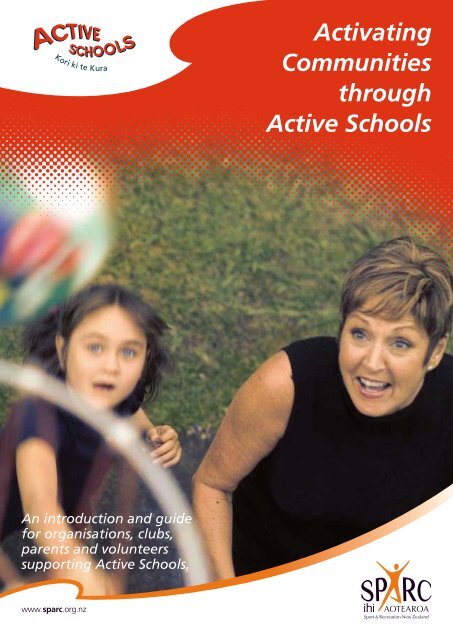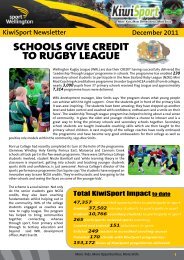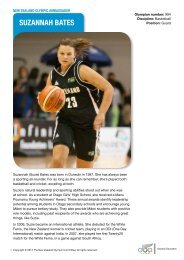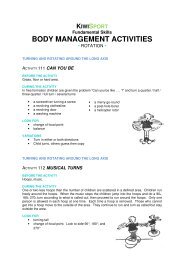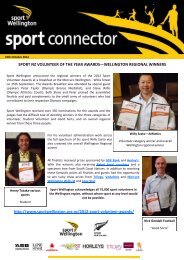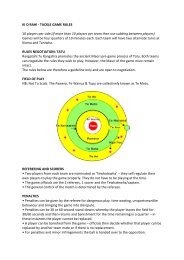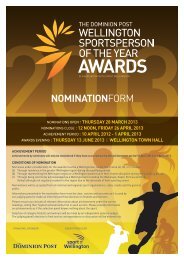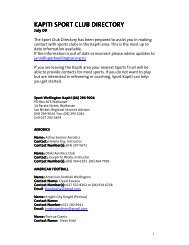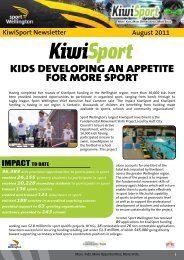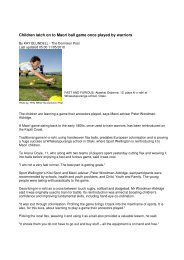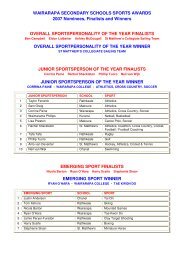Activating Communities through Active Schools - Sport Wellington
Activating Communities through Active Schools - Sport Wellington
Activating Communities through Active Schools - Sport Wellington
Create successful ePaper yourself
Turn your PDF publications into a flip-book with our unique Google optimized e-Paper software.
<strong>Activating</strong><br />
<strong>Communities</strong><br />
<strong>through</strong><br />
<strong>Active</strong> <strong>Schools</strong><br />
An introduction and guide<br />
for organisations, clubs,<br />
parents and volunteers<br />
supporting <strong>Active</strong> <strong>Schools</strong>.<br />
www.sparc.org.nz
1<br />
<strong>Activating</strong> <strong>Communities</strong> <strong>through</strong><br />
<strong>Active</strong> <strong>Schools</strong><br />
Introduction<br />
Giving children a head-start into an active life.<br />
<strong>Active</strong> <strong>Schools</strong> is all about encouraging New Zealand children to choose and enjoy physical<br />
activity. In every community and region, the more that schools, organisations and clubs work<br />
together to achieve this goal, the more our nation’s children will benefit.<br />
As a club or organisation (or as a parent or volunteer) you can play an important role in<br />
supporting <strong>Active</strong> <strong>Schools</strong>. There are significant benefits. It’s a win all round:<br />
1. for the children,<br />
2. for your organisation or club,<br />
3. for the whole school community,<br />
4. for your own skill-learning and involvement in activity – and ultimately for the next<br />
generation of New Zealanders.<br />
This SPARC resource presents the thinking behind <strong>Active</strong> <strong>Schools</strong>, and offers you a guide to the<br />
successful implementation of an <strong>Active</strong> School community. You’ll find proven strategies and<br />
ideas to support involvement <strong>through</strong> a whole school community approach.<br />
To know more contact activeschools@sparc.org.nz<br />
Acknowledgement:<br />
SPARC (<strong>Sport</strong> and Recreation) express their sincere appreciation to the people and<br />
organisations that contributed both directly and indirectly to this <strong>Active</strong> <strong>Schools</strong> resource.<br />
In particular, Emma Harris, on secondment from <strong>Sport</strong> Waikato, who assisted in the original<br />
content selection.
2<br />
Table of<br />
Contents<br />
Introduction 1<br />
The 3 Key Drivers for all <strong>Active</strong> <strong>Schools</strong> 3<br />
An overview 4<br />
What makes an <strong>Active</strong> School Community? 5<br />
The Benefits: for children, parents / whànau, schools, community groups,<br />
sport / recreation clubs / organisations 6<br />
Creating a whole school community approach 8<br />
Applying the School Community Planning Cycle 12<br />
Developing school community organisation and environment 17<br />
Providing child centered physical activity experiences 20<br />
Building community links and partnerships 25<br />
Resources to support your work 29<br />
Contact us 31
ACTIVATING COMMUNITIES THROUGH ACTIVE SCHOOLS<br />
3 KEY DRIVERS<br />
3<br />
The<br />
3 Key Drivers<br />
for all <strong>Active</strong> <strong>Schools</strong><br />
<strong>Active</strong> <strong>Schools</strong> is a crucial part of New Zealand’s commitment to inspire<br />
and support children to get active. <strong>Active</strong> schools is:<br />
1 Child centred. <strong>Active</strong> <strong>Schools</strong> provides opportunities for physical<br />
activity based on children’s needs, abilities and interests.<br />
2 Owned by the whole school community. An <strong>Active</strong> School<br />
involves the whole community. The whole school community takes<br />
ownership to create and sustain an active environment and offer<br />
programmes to enhance physical activity.<br />
3 Ongoing – and lifelong! An <strong>Active</strong> School is part of, and<br />
contributes to, an active community over time. Consistent<br />
messages and quality experiences encourage children into<br />
lifelong participation.
4<br />
<strong>Active</strong> <strong>Schools</strong><br />
An overview<br />
Success depends most of all on sharing and embracing the <strong>Active</strong> <strong>Schools</strong><br />
attitude, to encourage every child to stay active for life.<br />
<strong>Active</strong> <strong>Schools</strong> is a big step forward for the health and wellbeing of New Zealand children.<br />
The ultimate goal is to boost the physical activity levels and the wellbeing of young<br />
New Zealanders. Physical activity refers to ALL movement: everyday living, recreation, exercise,<br />
and organised sport.<br />
<strong>Active</strong> <strong>Schools</strong> targets both opportunities and the potential barriers to physical activity, IN AND<br />
AROUND school communities. It aims to build awareness, skills and knowledge about quality<br />
physical activity. It aims to strengthen the community connections that are crucial to making<br />
quality physical activity experiences happen.<br />
Working together is vital. <strong>Active</strong> <strong>Schools</strong> is the responsibility of the WHOLE SCHOOL<br />
COMMUNITY. Children are most likely to enjoy, benefit from and continue activity when they<br />
gain consistent messages and support – from everyone across the community.<br />
The Whole School Community spans:<br />
• All children<br />
• Parents / whànau<br />
• School teachers, senior management, Boards of Trustees<br />
• Clubs and physical activity providers<br />
• Regional sports trusts<br />
• School support services<br />
• National and regional sport and recreation organisations<br />
• Local iwi<br />
• District health boards<br />
• Public health units<br />
• Local and regional councils<br />
• Community service / health organisations<br />
• Commercial operators.
ACTIVATING COMMUNITIES THROUGH ACTIVE SCHOOLS<br />
WHAT MAKES AN ACTIVE SCHOOL COMMMUNITY?<br />
5<br />
What makes an<br />
<strong>Active</strong> School<br />
Community?<br />
An <strong>Active</strong> School community provides a wide range of physical activities<br />
and opportunities, in and out of school hours.<br />
While one <strong>Active</strong> School community may look very different from another, there are broad<br />
qualities for all. These include:<br />
• Creating / maintaining processes to make physical activity a key part of the whole<br />
school community<br />
• Having a physical / social environment that promotes enjoyable regular physical activity<br />
for all children<br />
• Considering, planning and delivering programmes of learning to meet children’s physical<br />
activity needs<br />
• Providing opportunities for staff, families / whànau, community groups and all children to<br />
engage in quality physical activity<br />
• Creating / managing mutually beneficial partnerships with community organisations and<br />
community members.
6<br />
The Benefits of<br />
<strong>Active</strong> <strong>Schools</strong><br />
The benefits of <strong>Active</strong> <strong>Schools</strong> are wide-reaching. <strong>Active</strong> <strong>Schools</strong> is designed<br />
to benefit New Zealand’s children and getting involved can deliver significant<br />
benefits to your organisation or club, as well as yourself.<br />
Children<br />
Parents / whànau<br />
<strong>Schools</strong><br />
Councils and community groups<br />
<strong>Sport</strong> / recreation clubs / organisations<br />
The benefits for children<br />
Physical…<br />
• Building and maintaining healthy bones, bodies and cardiovascular systems<br />
• Developing movement control, co-ordination and competence<br />
• Reducing risk of future health conditions such as heart disease, obesity, cancer<br />
• Increasing stamina.<br />
Mental…<br />
• Supporting academic achievement and discipline<br />
• Offering new life experiences<br />
• Enhancing brain development<br />
• Reducing stress<br />
• Building leadership, problem solving, planning and decision making skills<br />
• Improving self-esteem, confidence and coping skills<br />
• Learning to deal with times of success and failure.<br />
Social…<br />
• Creating opportunities to make friends<br />
• Developing values such as dedication, honesty, courage and fairness<br />
• Building communication and peer interaction skills<br />
• Supporting family / whànau involvement in learning<br />
• Bringing communities together<br />
• Having great fun!
ACTIVATING COMMUNITIES THROUGH ACTIVE SCHOOLS<br />
THE BENEFITS OF ACTIVE SCHOOLS<br />
7<br />
The benefits for parents / whànau<br />
• Gaining valuable opportunities to take part in children’s learning and development<br />
• Valuing children’s participation / increasing skill in physical activity<br />
• Increasing positive activity / healthy living<br />
• Gaining social interaction <strong>through</strong> schools, clubs, community groups<br />
and other parents<br />
• Getting closely involved in planning / delivery of physical activity<br />
• Gaining important new skills by leading activities, teams or events.<br />
The benefits for schools<br />
• Developing mutually beneficial partnerships with parents, children, community groups,<br />
community facilities, and other schools<br />
• Enhancing children’s performance in physical activity in / beyond school<br />
• Supporting confident and competent teachers of physical education<br />
• Celebrating school physical activity achievements locally, regionally and nationally<br />
• Establishing a physical activity culture that is owned and valued by the whole<br />
school community<br />
• Linking with other educational initiatives<br />
• Addressing requirements relating to physical activity as expressed in the<br />
National Education Guidelines.<br />
The benefits for councils / community groups<br />
• Gaining access to whole school community resources, such as play areas, sports<br />
equipment, community gardens<br />
• Working alongside schools to promote community activity opportunities such<br />
as sports clubs and recreation events<br />
• Enhancing school-community relations<br />
• Boosting community profile<br />
• Building understanding of children’s needs<br />
• Tapping into enthusiasm of young people to develop physical activity opportunities in the<br />
local community<br />
• Helping reduce community social problems.<br />
The benefits for sport / recreation clubs /<br />
organisations<br />
• Increasing the number of children choosing and enjoying the sport /<br />
recreation activity<br />
• Enabling children to know where to go and who to contact, to get involved<br />
• Creating opportunities to support children with talent (a secondary consideration to<br />
getting ALL children involved)<br />
• Connecting with parents / whànau who have skills and enthusiasm to contribute<br />
• Enhancing school-community relations<br />
• Boosting community profile.
8<br />
Creating a<br />
whole school<br />
community approach<br />
A successful whole school community approach sees ALL key partners<br />
collaborating to promote CONSISTENT messages and actions.<br />
A whole school community approach will:<br />
• Build physical activity into the school communities<br />
• Create consistent policies and procedures for groups and organisations working<br />
with schools to deliver physical activity<br />
• Create opportunities and structures to involve the whole school community in<br />
physical activity.<br />
The benefits:<br />
• Children gain regular quality physical activity opportunities<br />
• Teachers, parents and other physical activity providers have more ability / confidence to<br />
provide opportunities<br />
• Strong partnerships within communities which focus on children’s well-being<br />
• Consistent messages about physical activity across the whole school community<br />
and learning programmes within the school<br />
• Creating an infrastructure where physical activity is a sustainable part of the<br />
school’s culture.<br />
Parents / whànau<br />
encouraged to be<br />
involved in planning<br />
and delivery of PA<br />
Senior<br />
management team<br />
provide leadership<br />
and commitment<br />
School PA policy /<br />
guidelines<br />
developed <strong>through</strong><br />
consultation<br />
Physical<br />
Activity<br />
Quality physical<br />
education<br />
programme<br />
PD and training<br />
for teachers,<br />
parents, and<br />
PA providers<br />
Children’s-voice<br />
influences PA<br />
opportunities<br />
offered<br />
<strong>Active</strong> transport<br />
strategies are<br />
promoted<br />
Provides broad<br />
co-curricular<br />
opportunities<br />
which promote PA<br />
School identifies<br />
and seeks to<br />
remove barriers<br />
to participation<br />
Involves<br />
community<br />
resources in PA<br />
provision<br />
Whole School Approach to Physical Activity, adapted from Healthy <strong>Schools</strong> Programme, England 2004
ACTIVATING COMMUNITIES THROUGH ACTIVE SCHOOLS<br />
CREATING A WHOLE SCHOOL COMMUNITY APPROACH<br />
9<br />
There are clear areas for schools to focus on in creating a whole school<br />
community approach to physical activity. Other organisations and parents /<br />
whànau play a vital role.<br />
For more information see Guidelines for Sustainable Physical Activity in School <strong>Communities</strong><br />
Having a clear plan greatly helps a school community in working out how to steadily improve<br />
their physical activity culture.<br />
The ideal is for schools to plan to develop all aspects of the ‘whole school community’<br />
at once. However this is a large task. In reality, planning may allow for different aspects to be<br />
developed over time.<br />
The following are all things for schools and the community to consider:<br />
Commitment of school leadership<br />
Policy / guidelines to ensure consistency<br />
Physical Education programmes<br />
Professional / personal development<br />
Community resources / facilities<br />
Co-curricular opportunities<br />
Parent / whànau involvement<br />
Children’s voice<br />
<strong>Active</strong> transport<br />
Removing barriers to participation.<br />
These areas are each discussed in the following:<br />
Commitment of school leadership<br />
School leadership (both principals and lead teachers) can commit to the whole school<br />
community approach in many ways, such as:<br />
• Promoting physical activity in the school strategic plan<br />
• Including targets for physical activity / education in the school’s annual plan<br />
• Having the principal / board of trustees actively support the school community physical<br />
activity team, to act as a driving force<br />
• Committing annual budgets for facilities and equipment for physical education / activity<br />
experiences; and for staff development in physical education.
10<br />
Policy / guidelines to ensure consistency<br />
When developing and reviewing policies / guidelines, schools need to establish ways to involve<br />
the whole school community. It is important that individual roles and responsibilities across the<br />
whole school community are identified and described.<br />
This planning will involve working with other organisations.<br />
Policies / guidelines may include:<br />
• Physical education<br />
• <strong>Sport</strong><br />
• Daily physical activity sessions<br />
• Break time and before / after school physical activity<br />
• Education outside the classroom.<br />
Physical Education programmes<br />
A quality physical education programme supports learning that is:<br />
• Based on the New Zealand curriculum and children’s needs<br />
• Covering a range of physical activities<br />
• Appropriate to each child’s ability<br />
• Clearly understood<br />
• Monitored and reported.<br />
For more information see Guidelines for Sustainable Physical Activity in School <strong>Communities</strong><br />
Professional / personal development<br />
Professional and personal development could include the support of teachers, parents, and<br />
other providers to:<br />
• Attend training in running physical activity experiences for children<br />
• Observe other physical activity providers<br />
• Discuss best practices with other schools and physical activity providers<br />
• Participate in physical activities and events (such as by supporting walking school buses,<br />
parent forums and ‘Have a go’ days).<br />
Community resources / facilities<br />
There are many ways for school communities to make the most of resources, such as:<br />
• Using facilities of sport and recreation clubs<br />
• Offering school facilities to sport and recreation clubs<br />
• Using local parks and community facilities<br />
• Communicating information about school and community events, clubs and facilities via<br />
newsletters and / or notice board.<br />
Co-curricular opportunities<br />
Broad co-curricular physical activity opportunities could involve:<br />
• Senior students / parents / physical activity providers running lunchtime games and<br />
exercise sessions<br />
• Whole school exercise sessions<br />
• Senior students / parents / physical activity providers running activity events, for example<br />
challenge courses, exercise to music, interclass games.
ACTIVATING COMMUNITIES THROUGH ACTIVE SCHOOLS<br />
CREATING A WHOLE SCHOOL COMMUNITY APPROACH<br />
11<br />
• <strong>Sport</strong> and recreation organisations assisting inter-school competitions, such as kapa haka,<br />
skipping, sporting events<br />
• <strong>Sport</strong> and recreation clubs supporting school clubs, such as gardening, hiking, martial<br />
arts clubs.<br />
Parent / whànau involvement<br />
Parents and whànau can be involved in <strong>Active</strong> <strong>Schools</strong> in many ways such as:<br />
• Policy development<br />
• Joining the school community physical activity team<br />
• Developing home-school partnerships for physical activity<br />
• Running lunchtime games<br />
• Taking children to sport events<br />
• Managing road crossings and walking school buses to encourage active transport.<br />
Children’s voice<br />
Children’s voice is all about involving the children in planning and decision-making.<br />
This may be encouraged by:<br />
• Gaining their views on ideal learning and activities<br />
• Ensuring children are represented on the school community physical activity team<br />
• Encouraging children to contribute to policy development <strong>through</strong> a student council<br />
• Assisting children to share responsibility for some programmes / maintenance<br />
• More about children’s voice<br />
<strong>Active</strong> transport<br />
<strong>Active</strong> transport strategies could involve:<br />
• Providing bike sheds / stands, storage for scooters and skateboards, speed bumps<br />
to reduce traffic speed near children<br />
• Territorial authorities influencing subdivision design to reduce road crossings<br />
• No-parking zones near school<br />
• Walking school buses.<br />
Removing barriers to participation<br />
The physical and social environments of school communities can create barriers to<br />
participation. Examples of removing barriers may include:<br />
• Increasing space to play<br />
• Increasing children’s access to equipment for lunchtime activity<br />
• Offering ground markings or wall targets<br />
• Having strategies to reduce put-downs / bullying<br />
• Developing skills of teachers, parents and physical activity providers to provide quality<br />
opportunities<br />
• Reducing costs, such as by accessing community sport and recreation facilities, getting<br />
help with sports equipment, transport costs<br />
• Having equipment (and ideas for different uses) to suit different skill levels<br />
• Providing ramps for children with disabilities.<br />
Strategies to remove these barriers may become part of the school community’s<br />
physical activity action plan.
12<br />
Applying the School Community<br />
Planning Cycle<br />
Introduction<br />
The school community planning cycle is a process to promote and<br />
manage physical activity opportunities. It leads to a clear action plan,<br />
allowing a school community to focus on priorities, monitor progress<br />
and evaluate results.<br />
Whether the school community is planning a single event or a long term plan such<br />
as building a school hall / gymnasium – a school community planning cycle will<br />
support success.<br />
The process assists community buy-in, agreed outcomes, shared planning, and<br />
celebrating achievement.<br />
Advantages<br />
Developing, implementing and evaluating an action plan <strong>through</strong> a school community<br />
planning cycle will help to:<br />
• Ensure quality opportunities for all children<br />
• Create sustainable practices<br />
• Engage the entire school and wider community<br />
• Establish effective partnerships<br />
• Reinforce positive messages about physical activity<br />
• Identify areas to develop personal skills of teachers, parents, and other providers<br />
• Promote the positive value the school offers children.
ACTIVATING COMMUNITIES THROUGH ACTIVE SCHOOLS<br />
APPLYING THE SCHOOL COMMUNITY PLANNING CYCLE<br />
13<br />
6 key steps<br />
Secure<br />
commitment<br />
of school leadership<br />
Celebrate<br />
share<br />
and<br />
knowledge<br />
Implement, monitor<br />
evaluate<br />
success and<br />
plans<br />
School Community<br />
Planning Cycle<br />
Develop<br />
a school<br />
community<br />
physical activity action plan<br />
Engage<br />
a driving<br />
force<br />
review<br />
consultation /<br />
Carry out school communiity<br />
School Community Planning Cycle, adapted from Healthy <strong>Schools</strong> Programme, England 2004<br />
The school community planning cycle generally involves six key steps.<br />
Secure commitment of school leadership<br />
Identify a driving force<br />
Carry out whole school consultation / review<br />
Develop an action plan<br />
Implement, monitor and evaluate<br />
Celebrate success and share knowledge<br />
1. Secure commitment of school leadership<br />
Commitment from school management, including board of trustees, is essential.<br />
Without this, competing priorities can prevent targets from being achieved.<br />
Commitment may require formal support at a board of trustees’ meeting.
14<br />
2. Engage a driving force:<br />
School Community Physical Activity Team<br />
People who are prepared to drive the <strong>Active</strong> <strong>Schools</strong> approach form a School Community<br />
Physical Activity Team. This team should meet regularly to plan and oversee implementation,<br />
monitor progress, and evaluate results.<br />
The team should ideally represent:<br />
• Teachers<br />
• Parents / whànau<br />
• Children<br />
• Community / iwi agencies<br />
• Local sport and recreation organisations / physical activity providers<br />
• Senior management / BOT.<br />
All members of the team should have clearly defined roles, such as clarifying who is<br />
responsible for:<br />
• Developing consultation processes<br />
• Overseeing analysis of data from consultation<br />
• Developing a school community action plan<br />
• Monitoring implementation of the action plan<br />
• Planning ways to celebrate achievement.<br />
• The team may be formed as a result of <strong>Active</strong> <strong>Schools</strong> or be an existing health promoting<br />
schools committee focusing on physical activity.<br />
3. Carry out school community<br />
consultation / review<br />
Consultation should involve parents, teachers / other staff, children, community agencies, and<br />
sport and recreation organisations.<br />
Consideration should be given to:<br />
• How all members of the school community will be consulted<br />
• How all aspects of the whole school community approach will be included<br />
• Consultation methods – sometimes a few random phone calls are more useful than<br />
a formal survey<br />
• Gathering key information only<br />
• Using easily-understood language<br />
• Analysing information<br />
• Sharing results with the school community.<br />
Questions that could be asked:<br />
• What physical activities are currently available for children?<br />
• Where / when do these activities take place?<br />
• Who is responsible for offering the activities?<br />
• What are the strengths and weaknesses of the current approach?<br />
• What other activities would most benefit the children?<br />
Consultation methods could include:<br />
• Face to face interviews<br />
• Short questionnaires, post box<br />
• Phone calls<br />
• Observations<br />
• Team meetings<br />
• Parent consultation evenings.
ACTIVATING COMMUNITIES THROUGH ACTIVE SCHOOLS<br />
APPLYING THE SCHOOL COMMUNITY PLANNING CYCLE<br />
15<br />
4. Develop a school community<br />
physical activity action plan<br />
A successful School Community Physical Activity Action Plan gives clear direction to how the<br />
school community aims to promote physical activity.<br />
The School Community Physical Activity action plan should answer 8 questions:<br />
1. Where are we now? Baseline data<br />
2. Where do we want to get to? Target<br />
3. Why do we want to get there? Rationale<br />
4. How are we going to get there? Actions<br />
5. What do we need to do to get there? Resources<br />
6. Who will assist us to get there? People<br />
7. How we will know we have got there? Evaluation<br />
8. When will we review our progress? Review date<br />
Key steps:<br />
1. Produce a clear draft<br />
2. Distribute the draft to relevant school community members (using school newsletter,<br />
web site, staff meetings, student councils etc)<br />
3. Get feedback by a set timeframe<br />
4. Revise action plan based on feedback<br />
5. Distribute final action plan to ALL school community members – with clear<br />
opportunities to contribute to the implementation.<br />
Action planning for an <strong>Active</strong> School is like planting a fruit tree. The whole environment will<br />
affect how the tree grows. The tree will depend on a strong support structure. It will have<br />
many branches and bear fruit. If the environment is positive it will continue growing and<br />
fruiting season after season.<br />
Leaves & Fruit =<br />
Long Term Outcomes<br />
Results<br />
Branches =<br />
Intermediate Outcomes<br />
Values, Attitudes, Health<br />
Status, Skills<br />
Atmosphere = Context<br />
Organisation, Community,<br />
Policy, Environment<br />
Trunk = Process<br />
What the school is doing<br />
Roots = Resources<br />
Developed by Kent Health & Education Partnership, England 2003
16<br />
5. Implement, monitor and evaluate plans<br />
The completed action plan drives implementation. Success depends on:<br />
• Gaining community support<br />
• Ensuring people have / gain necessary skills with professional development or training<br />
• Adequate resources allocated by school leadership or organisations from the whole<br />
school community<br />
• Responding to any developments that impact on completing tasks within<br />
the timeframe.<br />
Monitoring of progress is essential. Monitoring depends on ongoing collection of information<br />
such as:<br />
• Budgets<br />
• Timescales<br />
• People input<br />
• Progress towards targets.<br />
Keeping an evidence portfolio is useful for ongoing monitoring. Evidence could be in the form<br />
of photographs and videos of successes, with written summaries of comments by children,<br />
parents and teachers.<br />
Evaluating results shows whether or not targets are met, and the factors influencing this.<br />
Factors are considered and suggestions made as to how they can be addressed in future<br />
action plans.<br />
6. Celebrate success and share knowledge<br />
Achieving change in a school community takes time and effort from many people.<br />
It is important to share and celebrate successes, across the whole school community.<br />
This gives recognition, offers thanks, and helps keep the ball rolling.<br />
Success can be celebrated by:<br />
• Articles / photos in local media<br />
• Reports in newsletters, web sites and notice boards – of both club and other<br />
organisations in the whole school community<br />
• Certificates<br />
• Special events.<br />
Sharing knowledge is about sharing what has been learned across the whole school<br />
community, and with other school communities.<br />
If your organisation deals with a number of schools you can play a key role here, as knowledge<br />
and experience is built up over time.<br />
Ways to share knowledge include:<br />
• Encouraging school cluster meetings<br />
• Running and promoting a school web site<br />
• Supporting blog sites<br />
• Establishing regional agency groups and forums.
ACTIVATING COMMUNITIES THROUGH ACTIVE SCHOOLS<br />
DEVELOPING SCHOOL COMMUNITY ORGANISATION AND ENVIRONMENT<br />
17<br />
Developing school community<br />
organisation and<br />
environment<br />
By embracing a whole school community approach, schools and physical<br />
activity providers create an ethos and environment that supports learning,<br />
participation and success in physical activity.<br />
The ethos is the way the whole school community ‘thinks’: special character, values, attitudes<br />
and beliefs. The environment is the physical and social character of the school community –<br />
the areas resources and facilities that encourage activity.<br />
School community ethos<br />
School community environment<br />
Case study – Physical Activity Environment<br />
School community ethos<br />
An ethos that celebrates physical activity is developed <strong>through</strong> a whole school community<br />
approach and applying school community planning. A school community that values the<br />
contribution of all children, staff, parents / whànau and wider community will be more<br />
successful in creating an ethos of physical activity.<br />
A school community ethos that promotes physical activity celebrates:<br />
• Participation of ALL children in many activities<br />
• Achievement, commitment, enjoyment, positive behaviour.<br />
The ethos can be seen in:<br />
• School mission, charter, annual plans, physical activity policies / guidelines, physical<br />
education programmes, reports to parents, ERO reports, etc.<br />
• Physical environment, for example, the grounds, facilities, equipment<br />
• Social environment, for example by children and adults playing happily together<br />
• Physical activity providers who are keen to develop their teaching / coaching skills.<br />
Strong partnerships across the whole school community lead to consistent messages about<br />
physical activity and promote positive behaviour in / beyond school. Opportunities for the<br />
community to be involved with physical activity include:<br />
• Parent / whànau involvement, for example at lunch times<br />
• Community notice board<br />
• Making school resources accessible to the community, for example by hiring equipment<br />
or buildings<br />
• Initiatives such as community gardens in school grounds<br />
• Home school partnerships<br />
• Involving parents / whànau and community in school events and celebrations
18<br />
• Recognising the contribution the local community make to the school<br />
• Recognising children’s involvement in the local community<br />
• Facilitating parents / whànau and / or staff walking groups.<br />
Improving<br />
physical<br />
environment<br />
Teaching /<br />
coaching<br />
and learning<br />
Partnerships<br />
with parents and<br />
community<br />
School Community<br />
Physical Activity Ethos<br />
Monitoring<br />
and evaluation<br />
Sharing of<br />
roles and<br />
responsibility<br />
Code of<br />
conduct /<br />
expectations<br />
School community environment<br />
Most children spend around seven hours a week at school but not in formal lessons.<br />
If the school environment promotes activity – more time is spent outside, developing<br />
both physical and social skills.<br />
Attractive and interesting school grounds and community facilities have a big impact on<br />
children’s participation, enjoyment and achievement in physical activity. A well-planned and<br />
maintained environment which caters for all children provides opportunities to explore and<br />
develop skills, and can promote positive behaviour.<br />
Ideas for a positive environment:<br />
• Playground markings and murals<br />
• Permanent, accessible and safe sports and recreation equipment<br />
• Play time boxes of physical activity equipment for each class<br />
• Both grassed areas and paved areas<br />
• Garden areas<br />
• Signs to encourage activity<br />
• Activity trails<br />
• Fencing to stop balls going out of bounds<br />
• Covered and shaded areas<br />
• Use of community facilities such as swimming pools, skateboard parks.
ACTIVATING COMMUNITIES THROUGH ACTIVE SCHOOLS<br />
DEVELOPING SCHOOL COMMUNITY ORGANISATION AND ENVIRONMENT<br />
19<br />
Case study – Physical Activity Environment<br />
The school community physical activity team involved children and staff in considering what<br />
physical activity opportunities they wanted. The team also collected data on accidents and<br />
negative playground behaviour. With this information, they developed an action plan to<br />
enhance the school playground and surrounding environment<br />
Children helped to design games, murals and playground marking. They also suggested ways<br />
to improve the grounds.<br />
The school approached local businesses for possible support. A local builder constructed a<br />
perimeter wall. A DIY store donated bags of compost, plants and seeds for a new garden area,<br />
and several benches.<br />
Parents and children painted the murals. A fund raising event covered the cost of playground<br />
markings and activities. These included specific areas for ball games, individual activities, group<br />
or peer led activities, gardening and a quiet area.<br />
Benches became buddy stops, where children could sit to show they wanted support or to be<br />
involved in activities. Older children were trained as peer leaders, to monitor<br />
these benches.
20<br />
Providing child centered<br />
physical activity<br />
experiences<br />
The physical activity opportunities provided by an <strong>Active</strong> School should be<br />
based on children’s needs, abilities, and interests.<br />
To develop confidence and competence, children need a VARIETY of opportunities<br />
to learn and apply movement skills. Issues to consider include:<br />
Modifying activities<br />
Providing variety of activities<br />
Adapting to different learning styles<br />
Environmental factors<br />
Areas for interests / ability<br />
Applying a child centred learning process<br />
Children’s voice in decision making<br />
Modifying activities<br />
Modifying activities may involve:<br />
• Applying the same skills in a different game<br />
• Using the same game, focusing on different skills<br />
• Modifying rules or equipment to change the challenges.<br />
Providing variety of activities<br />
Providing a variety of activities may involve:<br />
• Competitive and non-competitive games<br />
• Individual and team games<br />
• Structured and spontaneous games / play<br />
• Repetitive skill learning and applying skills in modified sports.<br />
Adapting to different learning styles<br />
When teaching / coaching, it is a good idea to demonstrate movements, explain movements,<br />
and ask the children what movements feel like.<br />
Children often have a preferred ‘learning style’ – stronger in visual, auditory or kinesthetic<br />
modes. For best results, use different styles of teaching / coaching depending on the child:<br />
• Visual learners often find it easier to visualise movements. Show demonstrations,<br />
pictures and diagrams.<br />
• Auditory learners often find it easier to follow the spoken word. Use clear, spoken<br />
instructions and questions.<br />
• Kinestheetic learners often need to touch objects or feel movement. Give them the<br />
opportunity to experience movement in learning.
ACTIVATING COMMUNITIES THROUGH ACTIVE SCHOOLS<br />
PROVIDING CHILD CENTRED PHYSICAL ACTIVITY EXPERIENCES<br />
21<br />
Environmental factors<br />
When planning and delivering physical activity learning experiences, it is important<br />
to consider factors impacting on children’s enjoyment and success, such as:<br />
• General environment of play area, grounds and equipment<br />
• Social influences from home, family or peers<br />
• Immediate influences such as a child being thirsty, hungry or tired<br />
• School and family / whànau expectations<br />
• Relationships with other children / adults<br />
• Child’s self-confidence in ability to perform and learn.<br />
Areas for interests / ability<br />
A helpful strategy can be to group children based on interests / ability. For example, during<br />
break time it may not be ideal for children who enjoy low-activity games like gutterball to be in<br />
the same area as children playing high-activity games like tag.<br />
Consider zoning the playground with a range of different activities in designated areas.<br />
Applying a child centred learning process<br />
Applying a learning process assures children of quality physical activity experiences.<br />
Create a<br />
supportive<br />
environment<br />
Connect the<br />
learning<br />
Big Picture<br />
first<br />
Activity<br />
Input<br />
Describe the<br />
outcomes<br />
Demonstrate<br />
Review for<br />
recall and<br />
retention<br />
A learning process adapted from Smith, A. (1998)<br />
Create a supportive environment<br />
• Ensure all children feel valued and safe with the place / people<br />
• Ensure they have clear expectations.<br />
Connect the learning<br />
• Ask children what they already know and what activities / skills they can<br />
already achieve.
22<br />
Identify the big picture<br />
• Help them identify why the learning is important.<br />
Describe the goal outcomes<br />
• Tell the children what you intend them to learn and how<br />
• Introduce the learning<br />
• Give children opportunity to explore / practice the new learning / skill.<br />
Encourage children to get active<br />
• Get the children to do the activity. Sometimes the ‘getting there’ is what matters most.<br />
For example if you are trying to promote cooperation skills this may be<br />
more important than the actual outcome of the activity.<br />
Have the children demonstrate<br />
• Get the children to demonstrate what they have learnt.<br />
• This develops their reflection skills and helps them to remember what they<br />
have learnt.<br />
Review children’s learning<br />
• Compare the children’s demonstration with what you intended them to learn.<br />
• Ask them to describe what they learnt<br />
• Ask them to describe how they could use this learning in other situations / places.<br />
Children’s voice in decision-making<br />
Children’s voice is essential to a true child centred learning process. Children’s voice is all<br />
about involving the children <strong>through</strong>out planning and decision-making. Children are given the<br />
opportunity to contribute and take on responsibilities.<br />
Children’s voice can assist the teacher / coach in planning the best learning. The approach also<br />
helps children gain excellent skills and knowledge. It creates shared ownership and ensures the<br />
results are relevant to children.<br />
Giving children a voice gives them opportunities to:<br />
• Apply knowledge and skills in everyday life<br />
• Learn how to balance individual rights and responsibilities<br />
• Make a positive contribution across the school and wider community<br />
• Learn that not everything is possible<br />
• Above all, take ownership of physical activity.
ACTIVATING COMMUNITIES THROUGH ACTIVE SCHOOLS<br />
PROVIDING CHILD CENTRED PHYSICAL ACTIVITY EXPERIENCES<br />
23<br />
Supporting children’s voice<br />
Shared power and decision making<br />
Children are involved in decision making<br />
Children’s views are taken into account<br />
Children are supported to express their views<br />
Children are listened to<br />
Pathway to Participaton, adapted from Shier. H. 1998.<br />
Children’s voice can be represented as steps on a ladder. Each rung brings increased<br />
participation / responsibility in decision making.<br />
Building children’s voice takes time. Always encourage children to take small achievable steps<br />
up the ladder.<br />
Strategies to engage children’s voice<br />
The key is involvement! There are many proven ways of engaging children’s voice, such as:<br />
• student councils<br />
• committees<br />
• questionnaires / surveys<br />
• peer work<br />
• consultation evenings<br />
• circle time.<br />
Getting started<br />
By answering the following, a school community can help encourage effective use of<br />
children’s voice.<br />
• What are we consulting about?<br />
Be clear about the limitations and boundaries of consultation. For example,<br />
playground environment, sport clubs, equipment, school PE curriculum, expected<br />
behaviour at lunchtime, options for out of hours activities.
24<br />
• When do we engage children’s voice?<br />
While it may not be possible to involve children in all decisions, the earlier they are<br />
involved the more they will take ownership for what happens and why.<br />
• How much power should children have?<br />
Be clear here. Some stages require more adult involvement. Children need to understand<br />
every decision relates to the next; meeting the needs of all is a SHARED process.<br />
• What are the benefits?<br />
Make sure children understand the benefits of them being involved, for them, and<br />
for others.<br />
• How do we assure fair children’s voice?<br />
Make sure all children are represented. Don’t just ask the academic pupils. Make sure<br />
boys and girls are equally represented. Make sure children from different cultures are<br />
equally represented. Involve any children with special needs.<br />
• What resources do we need?<br />
Define adult involvement, and the budget.<br />
• What about feedback?<br />
Children need to be kept informed about progress, including reasons why something has<br />
not happened.<br />
• How to show their contribution is valued?<br />
Make sure children see their contribution is taken seriously or they are likely to lose trust<br />
and interest.
ACTIVATING COMMUNITIES THROUGH ACTIVE SCHOOLS<br />
BUILDING COMMUNITY LINKS AND PARTNERSHIPS<br />
25<br />
Building<br />
community links<br />
and partnerships<br />
The development of children is enhanced when children, teachers, parents<br />
/ whànau, sport and recreation organisations, territorial authorities and<br />
community groups all have a shared vision – and work in partnership to<br />
achieve it.<br />
Successful partnerships are all about mutual respect and understanding, with clear roles and<br />
responsibilities. Successful partnerships do not place unwanted demands on individuals /<br />
groups. They also do NOT replace responsibilities.<br />
Developing partnerships with parents / whànau<br />
Developing partnerships between schools and community physical activity providers<br />
Developing partnerships with parents / whànau<br />
When developing partnerships across the whole school community, the involvement of parents<br />
/ whànau is crucial. As members of a school community, you could consider:<br />
• Current communication channels between schools / community groups,<br />
parents / whànau<br />
• What other methods could be used, and when?<br />
• What needs to be said?<br />
• What needs to be asked?<br />
• What will the benefits be?<br />
• How can as many people as possible be motivated?<br />
• How will the partnerships and communication with parents / whànau be<br />
kept working?<br />
These questions should ideally be asked on an ongoing basis. There can never be too much<br />
communication across the whole school community.<br />
Case studies – parent / whànau involvement<br />
Four examples of parent / whànau partnerships in action.<br />
Training for parents / whànau<br />
Purchasing equipment<br />
Parent / whànau – school / club links<br />
Accessing CoachForce support
26<br />
Case study – Training for parents / whànau<br />
The school’s consultation with parents and the wider community showed a number of<br />
grandparents were providing children with before / after school care.<br />
The school established that some of these grandparents had a keen interest in a range<br />
of sporting activities, and a few had extensive hands-on experience. The school invited<br />
grandparents to the school community physical activity team meeting, to see if there were<br />
ways they could work together to promote children’s activity out of school time.<br />
Although keen, the individuals lacked initial confidence in delivery. Working <strong>through</strong> the<br />
Regional <strong>Sport</strong>s Trust, the school contacted the CoachForce officer, who helped train and<br />
mentor the grandparents, until they had the confidence and skills to run the after-school<br />
programmes themselves.<br />
Case study – Purchasing equipment<br />
School consultation with the community about physical activity interests and opportunities<br />
identified a number of individuals, including children, with an interest in cycling as a family<br />
activity. Evaluating the feedback revealed that in many families only the child owned a bike and<br />
in some families no one had a bike. The school decided to apply to the local Council for funding<br />
and hold a school fund raising event with a focus on physical activity.<br />
These efforts raised enough money to buy four adult bikes and four children’s bikes. The<br />
school made the bikes available for hire to the local community. By charging a nominal amount<br />
they fully covered the ongoing cost of maintenance.<br />
Case study – Parent / whànau-School / club links<br />
A member of CoachForce was assisting a school that had identified swimming as a key area<br />
for development. They worked with the school to gain parental involvement and start a<br />
programme to identify talented children.<br />
The swimming programme was run at school with information sent home to parents about<br />
additional swimming lessons and clubs. The school hosted a swimming event and invited<br />
parents. The school identified children with swimming talent and passed their names on to the<br />
CoachForce member.<br />
A communication channel was set up <strong>through</strong> the school from / to the CoachForce member<br />
and parents of keen swimmers. This promoted links between children and swimming clubs.<br />
Case study – Accessing CoachForce support<br />
In a Regional <strong>Sport</strong>s Trust, the CoachForce manager and <strong>Active</strong> <strong>Schools</strong> facilitator<br />
meet regularly.<br />
The <strong>Active</strong> <strong>Schools</strong> facilitator works with a cluster of schools to assist them in identifying<br />
parents who are potential coaches. Names are passed on to the CoachForce manager<br />
who contacts the regional sports organisation and / or club. The RST and club ensure te<br />
parents receive on-going training and support as required.<br />
Developing partnerships between schools and<br />
community physical activity providers<br />
An effective parnership between your organisation and school depends on everyone having<br />
clear expectations and responsibilities; with all participants being empowered to play a valuable<br />
and rewarding role. There are a number of important considerations.
ACTIVATING COMMUNITIES THROUGH ACTIVE SCHOOLS<br />
BUILDING COMMUNITY LINKS AND PARTNERSHIPS<br />
27<br />
Considerations to help your initial planning<br />
Agreeing a code of expectation<br />
Considerations for programmes<br />
Considerations for sports / physical activity providers<br />
Considerations for Territorial Authorities<br />
Looking ahead<br />
Considerations to help your initial planning<br />
• What are the school’s / your organisation’s needs?<br />
• How do these needs relate to the wider community?<br />
• What are the communication channels between school and your / other organisation(s),<br />
and how can they be developed? (A liaison person who talks with schools to understand<br />
their needs may be a good idea.)<br />
• What are the benefits of the partnership(s)?<br />
• How to best get started? (Consider contributing to the school community’s physical<br />
activity action plan<br />
• How can you include the school in your organisation’s consultation processes?<br />
Agreeing a code of expectation<br />
A code of expectations is crucial to manage expectations, needs and responsibilities of schools<br />
and providers.<br />
A code of expectation:<br />
• Identifies how provider and school will successfully deliver physical activity<br />
learning to children<br />
• Describes the school’s / provider’s roles and responsibilities<br />
• Focuses on creating positive physical activity experiences for the children<br />
• Establishes consistent delivery and expectation during / out of school time<br />
• Reflects the school’s values, and ethos<br />
• Respects the provider’s goals / aims.<br />
Codes of expectation differ depending on needs but some elements are mandatory:<br />
• Alignment with school / organisation practices<br />
• Assurance of relevant learning for children and staff<br />
• Provision of a safe learning environment<br />
• Child centred and inclusive activities / programmes.<br />
Considerations for programmes<br />
As a provider it is essential to ensure programmes / activities:<br />
• Encourage participation and fun for ALL children<br />
• Are inclusive and can be modified to meet different children’s needs<br />
• Are positive and focused forward<br />
• Emphasise modified games rather than drills
28<br />
• Focus on quality not quantity (it is better to provide thorough programmes in less schools<br />
than “have a go” session in many schools)<br />
• Use a variety of equipment and approaches<br />
• Recognise participation and achievement.<br />
Considerations for sports / physical activity providers<br />
• Aim to cover fewer sports / activities in greater depth, enabling learning<br />
in clear steps<br />
• Developing children should always come before developing the sport / activity – focus on<br />
who is coached rather than what is coached<br />
• If necessary, support training of additional staff / volunteers to deliver programmes<br />
• All people representing your organisation should receive professional development and<br />
use a child centred philosophy<br />
• Programmes should not be used simply as opportunities to identify talent<br />
• Ensure regular communication with schools<br />
• Communicate all opportunities (such as registration, events, training, volunteer<br />
opportunities) and how the school community can be involved.<br />
Additional considerations for Territorial Authorities<br />
• Aim for long term planning to remove barriers to participation<br />
• Consult with / partner schools to develop multi-use facilities (such as play areas on /<br />
near school property)<br />
• Support active transport initiatives (for example, controlled crossings, walking school<br />
buses, split pedestrian islands, employing school travel planners)<br />
• Offer holiday programmes using school sites<br />
• Ensure regular communication with schools<br />
• Communicate all opportunities (such as registration dates, events, resources / facilities<br />
available, costs and rebates for schools) and how the school community can be involved.<br />
Looking ahead<br />
Strong ongoing communications ensure everyone works to the same vision. Looking to the<br />
months and years ahead:<br />
• Stay involved in the school community physical activity team<br />
• Support clear communications across the school community, perhaps with a shared<br />
database of contacts<br />
• Recognise the support of all participants<br />
• Recognise the importance of your own work – by helping children to get active and enjoy<br />
it, you are helping make a difference to the future of New Zealand society.
ACTIVATING COMMUNITIES THROUGH ACTIVE SCHOOLS<br />
RESOURCES TO SUPPORT YOUR WORK<br />
29<br />
Resources<br />
to support your work<br />
You can call on a range of publications as well as proven expertise, to support<br />
your work in activating communities <strong>through</strong> <strong>Active</strong> <strong>Schools</strong>.<br />
You are welcome to call on the expertise of <strong>Active</strong> School Facilitators. These people are based<br />
in Regional <strong>Sport</strong>s Trusts around New Zealand. Your region’s Facilitator can help in establishing<br />
a successful whole school community planning process.<br />
SPARC can also provide information about best practices in the sport and recreation sector.<br />
To know more, or to find out your region’s Facilitator call 0800 <strong>Active</strong> (228483).<br />
<strong>Active</strong> <strong>Schools</strong> Toolkit<br />
This has been produced by SPARC (<strong>Sport</strong> and Recreation New Zealand). It is aimed primarily<br />
at schools, but the information may well be of value to your involvement in the whole school<br />
community. The toolkit includes:<br />
• Get Ready. For principals, management teams and Boards of Trustees; introducing and<br />
maintaining a physical activity culture at the school.<br />
• Get Started. For teachers looking at introducing physical activity into the classroom.<br />
Over 90 practical, fun activities for outside the classroom across the curriculum and with<br />
family / whànau.<br />
• Get Going. Twenty curriculum-based activity cards offering ways to include physical<br />
activity in a planned programme.
30<br />
• Get into It. A CD ROM with interactive activities, ideas, and physical activity options<br />
for children.<br />
• Outdoor Activities: Guidelines for Leaders. This describes current accepted practice<br />
for more than 40 outdoor activities.<br />
• Healthy Eating in <strong>Active</strong> <strong>Schools</strong>. This booklet uses a whole school approach to<br />
improve healthy eating for children.<br />
To download a copy of the <strong>Active</strong> School’s Toolkit, visit www.sparc.org.nz<br />
<strong>Active</strong>Mark<br />
<strong>Active</strong>Mark is a development tool schools can use to support / guide the development<br />
of the Whole School Community Physical Activity Culture. Using the <strong>Active</strong>Mark tool will<br />
provide schools with guidance and direction in addressing physical activity programmes<br />
<strong>through</strong> the various stages using thhe action planning process.<br />
Other helpful publications<br />
Guidelines for Sustainable Physical Activity in School <strong>Communities</strong>. This is a guide for school<br />
principals and teachers / managers of physical education programmes.<br />
It’s all about children and young people<br />
These guidelines assist providers to implement a child and young person centred philosophy<br />
in sport and recreation. To view them, visit www.sparc.org.nz<br />
Coach development framework<br />
These guidelines set the future philosophy and direction for coach development in<br />
New Zealand.<br />
Coaches’ code of ethics<br />
This sets out expectations for conduct and behavior for anyone involved in coaching.<br />
Guide to Strategic Planning for Physical Activity<br />
These guidelines for territorial authorities assist with planning regional physical<br />
activity strategies.<br />
Kiwidex Manual<br />
Fun, informal activities to promote daily physical activity and games for children.<br />
Fundamental Movement Skills<br />
This resourcee uses play and simple activities to help children master basic movement skills<br />
<strong>through</strong> play and games.
ACTIVATING COMMUNITIES THROUGH ACTIVE SCHOOLS<br />
CONTACT US<br />
31<br />
Contact Us<br />
To know more, or for advice or support, please contact us at:<br />
SPARC, Level 4, Dominion Building, 78 Victoria Street,<br />
PO Box 2251, <strong>Wellington</strong>, New Zealand<br />
Phone: +64 4 472 8058 Fax: +64 4 471 0813<br />
www.sparc.org.nz<br />
An <strong>Active</strong> School community is a positive community … congratulations on<br />
your involvement.
Level 4, Dominion Building, 78 Victoria Street,<br />
PO Box 2251, <strong>Wellington</strong>, New Zealand<br />
Phone: +64 4 472 8058 Fax: +64 4 471 0813<br />
www.sparc.org.nz<br />
ISBN: 1-877356-57-3


